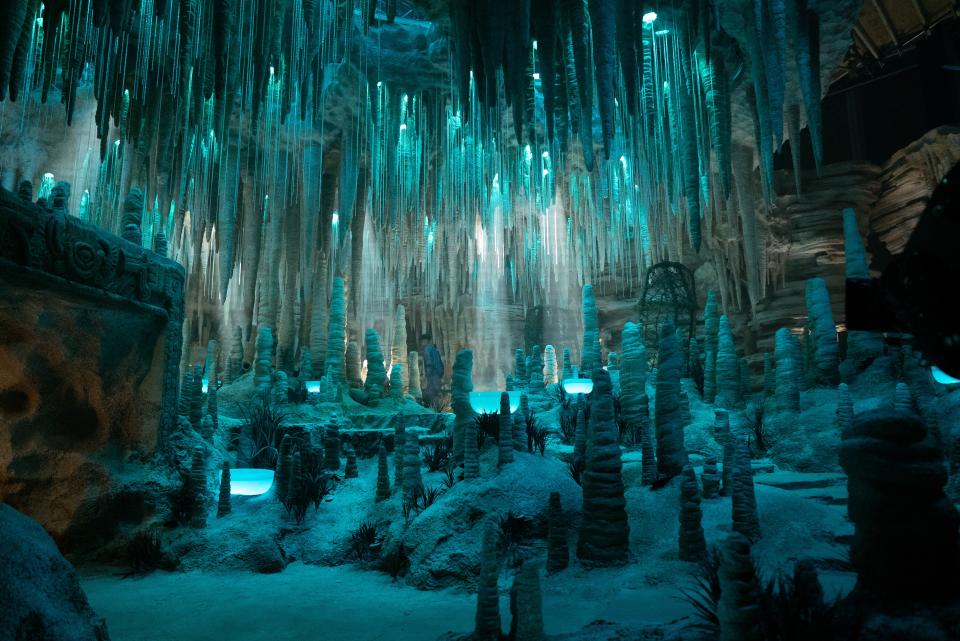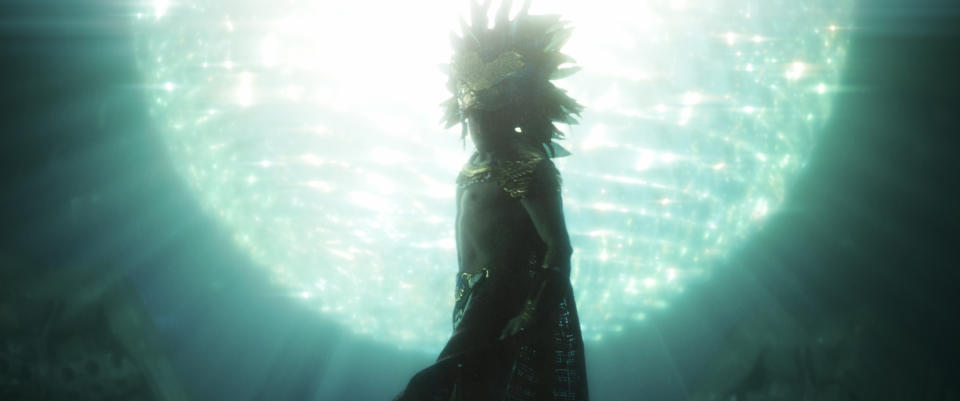‘Wakanda Forever’ Production Designer Hannah Beachler Dives Into the History of Talokan

- Oops!Something went wrong.Please try again later.
- Oops!Something went wrong.Please try again later.
- Oops!Something went wrong.Please try again later.
Oscar-winning production designer Hannah Beachler was tasked by director Ryan Coogler with making two movies in one for “Black Panther: Wakanda Forever”: a more hard tech expansion of the hardware and vehicles in Wakanda, along with the undersea world of Talokan. The new setting was conceived as a mirror of the Afrofuturist utopia introduced in “Black Panther”: Another ancient civilization — in this case, Mayan — forced into seclusion, but able to survive thanks to the powerful energy source of vibranium. Led by King Namor (Tenoch Huerta), the Talokans were driven into the ocean by Spanish persecution and slaughter in the 16th century, as a result of magical powers.
Beachler prepared a 400-page bible, similar to the one she previously devised for Wakanda, over the course of two years. She not only had to figure out how to root Talokan in Mayan culture, but also how its people could plausibly live underwater. Breathing alone was a complicated system, inspired by jellyfish absorbing oxygen from water directly into their bodies. It was determined that the Talokan would sleep like otters that wrap themselves in kelp blankets.
More from IndieWire
This Was the Worst Thanksgiving Weekend in Box-Office History.
Cinematographer Autumn Durald Arkapaw Is Bringing a Visual Subtlety to the Marvel Cinematic Universe
“The bible had a timeline and the migration pattern from the Yucatán to the Puerto Rico Trench spanning 500 years,” Beachler told IndieWire. “What did that look like and where did they go? And how did their architecture and knowledge of water and being underwater grow? They started genetically engineering kelp corn that we talked about a lot, and that became their main crop, like maze was for Maya — and they took that to the ocean. We did all the backstory work, we talked to cultural experts and also oceanographers, marine biologists, ocean management about invasive and intrusive species, hydrothermal events, and the creatures under the sea. They were 12,000 feet down and we really needed to learn what that meant in theory. This was more fantastical than Wakanda.”

Annette Brown
Beachler patterned the Talokan after Mayans who lived in the Chiapas region of southern Mexico and based Namor after child ruler King Pakal. They had a river that ran through the Temple of the Inscriptions, and were well versed in water, the first to make rubber clothing, and understand how to farm in wetlands. “I thought of that group of people that migrated to the coast of the lowlands of the Yucatan,” Beachler continued. “They fished and traded in the ports, and they were very family- and community-oriented.”
But Beachler had to then translate that to surviving under water. “What did they eat? How did they build? How did they live?,” she said. First, she took them from the coast of Tulum in the gulf and tracked them for centuries in shallow water. They lived in a series of interconnected caves with stalagmites and stalactites. We witness this in the film when Namor takes Wakandan princess Shuri (Letitia Wright) on a tour. This became an immense set, lit through bioluminescence in collaboration with cinematographer Autumn Durald Arkapaw.
There’s also Namor’s private room containing a vast series of murals on the walls depicting his story and the history of the Talokan through their interaction with nature and animal spirits. Some sets were in tanks, such as a 20-foot one with added scenery, where underwater stunt people played the traditional Mesoamerican ballcourt game through a 7-foot hoop.
However, the Talokan continued getting pushed farther into the ocean depths of the Atlantic, where it’s much darker. “There was this idea of not knowing up from down and we wanted to treat water like space, where they seem to float,” said Beachler. “That’s why Shuri’s in the big space uniform — the underwater submersible suit. She’s like an alien to them. At the same time, we didn’t want the architecture of the buildings to seem alien. We wanted it to feel human in a sense because they still carry that with them. They use jade to cut stone and they create heavier architecture living in cliff side caves.”

Annette Brown
The biggest code to crack, though, was the lack of light and reflection of color at 12,000 feet. But what they found in their studies were algae and other biological material that created bioluminescence. This breakthrough enabled the filmmakers to plausibly convey muted colors through the diffuse murk with the aid of blue light and other bioluminescent means.”Over the years, the Talokan brought this certain type of red algae,” said Beachler. “They would take limestone, crush it, paste it, put pigment in it to create the red, and paint it on the temples.”
The Talokan engineers even discovered a way of making an artificial sun with the help of vibranium. This became a visual effect from Wētā FX that enhanced the dramatic effect in Namor’s Throne Room when he prepares for war with Wakanda.

Courtesy of Marvel Studios
The Talokan also incorporated vibranium into jewelry and weaponry, such as the water bombs. “I think [the jewelry] is something they did when they discovered it was so beautiful,” Beachler said. “And then to protect themselves, the scientists learned how to use this to their advantage.”
In terms of tying Wakanda and Talokan so closely together, Beachler credits Coogler for continuing the thematic thread of diaspora and survival. “I love how Wakanda wonders if they should show themselves to the world in the first film, and how that found itself through to Talokan,” she said. “And they’re not debating it. They have decided they should not. So much of the Mayan civilization was lost. Their books were burned, they were not allowed to speak their indigenous language, they were forced to learn Spanish. And that mirrors Wakanda as far as the diaspora for Black Americans and their African history. These two cultures have gone through so much of the same destruction from outside forces.”
Best of IndieWire
Sign up for Indiewire's Newsletter. For the latest news, follow us on Facebook, Twitter, and Instagram.


